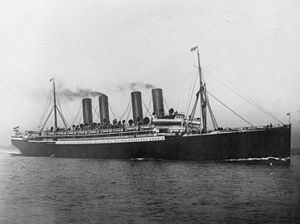SS Kaiser Wilhelm der Grosse
| |
This article does not cite any references or sources. Please help improve this article by adding citations to reliable sources. Unsourced material may be challenged and removed. (July 2009) |

| |
| Career | |
|---|---|
| Name: | SS Kaiser Wilhelm der Grosse |
| Owner: | Norddeutscher Lloyd |
| Port of registry: | 20px Germany |
| Builder: | Stettiner Vulcan, Stettin |
| Laid down: | 1896 |
| Launched: | 4 May 1897 |
| Christened: | 4 May 1897 |
| Maiden voyage: | 19 September 1897 |
| Fate: | scuttled at the Battle of Rio de Oro, August 26, 1914 wreck later scrapped in 1952 on the spot in the shallow waters |
| General characteristics | |
| Tonnage: | 14,349 gross tons |
| Length: | 655 feet (200.1 m) |
| Beam: | 65.8 feet (20.1 m) |
| Installed power: | 33,000 horsepower |
| Propulsion: | Triple expansion reciprocating engines driving twin propellers |
| Speed: | 22.5 knots |
| Capacity: | 1506 passengers (206 first class, 226 second class, 1074 third class) |
| Crew: | 488 |
SS Kaiser Wilhelm der Grosse, named after the first emperor of the new (post-1871) German Empire, Kaiser Wilhelm I, was a German ocean liner of the Norddeutscher Lloyd (NDL) shipping line. She is notable for a number of things, including being the first German ship to win the Blue Riband and the first passenger ship (although acting as an armed merchant cruiser at the time) sunk in World War I.
Contents
Career
She was built by Vulcan shipyards in Stettin and launched on 4 May 1897. She made her maiden voyage on 19 September of that year, from Bremerhaven to New York. In November 1897, she set an eastbound North Atlantic crossing record from Sandy Hook to the Needles, and four months later she captured the westbound Blue Riband, taking it from Cunard's Lucania. She held these records until the rival Hamburg-Amerika Line's Deutschland took the eastbound record in July 1900 and the westbound one in September 1903. The fact that German ships took over this famed prize eventually led the British to build their Mauretania and Lusitania duo.
The Kaiser Wilhelm der Grosse became the first liner to have a commercial wireless telegraphy system when the Marconi Company installed one in February 1900. Communications were demonstrated with systems installed at the Borkum Island lighthouse and Borkum Riff lightship 30 km northwest of the island, as well as with British stations. The ship was also the first liner to have four funnels, which would become a symbol of safety and prestige. Like many four-funneled liners, Kaiser Wilhelm der Grosse did not actually require that many. She had only two uptake shafts from the boiler rooms, which then each branched into two to connect to the four funnels- this design is the reason for the funnels being unequally spaced.
The ship escaped a massive fire at NDL's Hoboken, New Jersey, piers in June 1900, which badly damaged her running mates, Main, Bremen and SS Saale, and killed 161 crewmen on those ships. Six years later, in November 1906, she was struck broadside while trying to cross in front of the Royal Mail's Orinoco; five passengers on Kaiser Wilhelm der Grosse were killed by the impact and a hole 21 meters (70 ft) wide by 8 meters (26 ft) high was ripped into her hull. An Admiralty Court found the accident to be entirely attributable to Kaiser Wilhelm der Grosse.
In 1914 she was modified to take 3rd and 4th class fares only, in order to make the most of the large demand for emigrant passages from Europe to North America.
World War I
In August 1914 the ship was requisitioned by the Kaiserliche Marine and converted into an auxiliary cruiser, assigned to commerce raiding in the Atlantic. She was fitted with six 10.5 cm (4 inch) guns and two 37 mm guns. After sparing two passenger ships because they were carrying many women and children, she sank two freighters before she herself was sunk on 26 August, 1914. She was caught refuelling off the shore of the then Spanish colony of Rio de Oro in western Africa by the old British 6-inch gunned cruiser HMS Highflyer. Badly outgunned, the ship eventually ran out of ammunition. The crew abandoned and scuttled her in shallow water. British sources at the time insisted that Kaiser Wilhelm der Grosse sank because of the damage inflicted by Highflyer. Whatever the cause, she was the first passenger ship sunk during World War I. With her starboard side sticking up out of the surface of the water, the Kaiser Wilhelm der Grosse was scrapped on the spot in 1952.
See also
| SS Kaiser Wilhelm der Grosse
]]- SS Kronprinz Wilhelm, sister ship of Kaiser Wilhelm der Grosse
External links
| Records | ||
|---|---|---|
| Preceded by Lucania |
Holder of the Blue Riband (Westbound) 1898 – 1900 |
Succeeded by Deutschland |
| Atlantic Eastbound Record 1897 – 1900 | ||
| |||||||||||
de:Kaiser Wilhelm der Große (Schiff) fr:Kaiser Wilhelm der Grosse it:Kaiser Wilhelm der Große ja:カイザー・ヴィルヘルム・デア・グロッセ (客船) no:SS «Kaiser Wilhelm der Grosse» pl:SS Kaiser Wilhelm der Große
- Articles lacking sources from July 2009
- Articles with invalid date parameter in template
- All articles lacking sources
- Pages with broken file links
- Ships of North German Lloyd
- World War I cruisers of Germany
- World War I commerce raiders
- Ships of the German Imperial Navy
- World War I passenger ships of Germany
- Blue Riband holders
- Ocean liners with four funnels
- World War I shipwrecks in the Atlantic Ocean
- 1897 ships
- Maritime incidents in 1914

